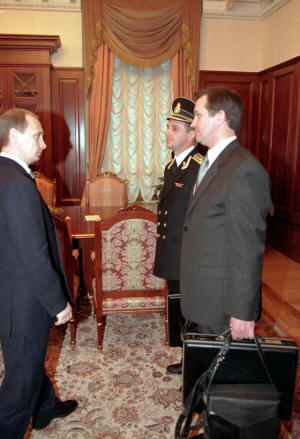Analysis-What is Russia's policy on tactical nuclear weapons?
 Send a link to a friend
Send a link to a friend
 [October 17, 2022]
By Guy Faulconbridge [October 17, 2022]
By Guy Faulconbridge
LONDON (Reuters) - The United States has
said the world faces the gravest nuclear danger since the 1962 Cuban
Missile Crisis because of remarks by Russian leader Vladimir Putin
during the Ukraine conflict, but Moscow says its position has been
misinterpreted.
Kyiv and its Western allies fear tactical nuclear weapons could be used
in battle after Putin and others warned Russia was prepared to use all
its vast arsenal in defence.
WHAT ARE TACTICAL NUCLEAR WEAPONS?
Academics and arms control negotiators have spent years arguing about
how to define tactical nuclear weapons (TNW). The clue is in the name:
they are nuclear weapons used for specific tactical gains on the
battlefield, rather than, say, destroying the biggest cities of the
United States or Russia.
Few people know exactly how many TNW Russia has because it is an area
still shrouded in traditions of Cold War secrecy.
Clearly, however, Russia has a huge numerical superiority over the
United States and the transatlantic NATO military alliance when it comes
to TNW: the United States believes Russia has around 2,000 such working
tactical warheads, 10 times more than Washington.
These warheads can be delivered via a variety of missiles, torpedoes and
gravity bombs from naval, air or ground forces. They could even be
simply driven into an area and detonated.

The United States has around 200 such weapons, half of which are at
bases in Europe. These 12-ft B61 nuclear bombs, with different yields of
0.3 to 170 kilotons, are deployed at six air bases across Italy,
Germany, Turkey, Belgium and the Netherlands.
The atomic bomb dropped by the United States on the Japanese city of
Hiroshima in 1945 was about 15 kilotons.
WHO GIVES THE RUSSIAN LAUNCH ORDER?
The president is the ultimate decision maker when it comes to using
Russian nuclear weapons, both strategic and non-strategic, according to
Russia's nuclear doctrine.
The so-called nuclear briefcase, or "Cheget" (named after Mount Cheget
in the Caucasus Mountains), is with the president at all times. The
Russian defence minister, currently Sergei Shoigu, and the chief of the
general staff, currently Valery Gerasimov, are also thought to have such
briefcases.
Essentially, the briefcase is a communication tool which links the
president to his military top brass and thence to rocket forces via the
highly secret "Kazbek" electronic command-and-control network. Kazbek
supports another system known as "Kavkaz".
Footage shown by Russia's Zvezda television channel in 2019 showed what
it said was one of the briefcases with an array of buttons. In a section
called "command" there are two buttons: a white "launch" button and a
red "cancel" button. The briefcase is activated by a special flashcard,
according to Zvezda.
If Russia thought it faced a strategic nuclear attack, the president,
via the briefcases, would send a direct launch order to general staff
command and reserve command units which hold nuclear codes. Such orders
cascade swiftly down different communications systems to strategic
rocket force units which then fire at the United States and Europe.
If a nuclear attack were confirmed, Putin could activate the so-called
"Dead Hand" or "Perimetr" system of last resort: essentially computers
would decide doomsday. A control rocket would order nuclear strikes from
across Russia's vast armoury.
HOW WOULD A TNW ORDER WORK?

The procedure for ordering a TNW strike is thought to be similar to that
of a strategic launch but there are key differences and much is unknown
due to the intense secrecy of nuclear command procedures.
When the Soviet Union collapsed in 1991, Russia had around 22,000 TNWs
while the United States had around 11,500. Most of these weapons have
been dismantled or are waiting to be dismantled.
The ones that remain are stored in at least 30 military bases and silos
under the control of the 12th Main Directorate of the defence ministry
(12th GUMO) headed by Igor Kolesnikov, who reports directly to the
defence minister.
[to top of second column]
|

Acting President and Prime Minster
Vladimir Putin (L) receives the briefcases that contain the system
for launching Russia's nuclear missles after the official ceremony
of transference of power in the Kremlin December 31. WAW/ME/File
Photo

To prepare a TNW strike, it is likely that Putin would consult with
senior allies from the Russian Security Council before ordering, via
the general staff, that a warhead be joined with a delivery vehicle
and prepared for a potential launch order.
These steps could be picked up by Western intelligence, as would
unusual Russian troop movements away from any potential target in
Ukraine or change to Russia's nuclear posture.
"I think Putin would signal and would want us to see that he was
moving towards nuclear weapons because he would like to get whatever
he wants for free," said Jeffrey Lewis, an arms control expert at
The Middlebury Institute of International Studies at Monterey.
"If you are going to use a nuclear weapon to send a very costly
signal, the first thing you do is say: ‘You know what I am going to
do, right?’. And then you might get what you are asking for and if
you don’t then you go through with it."
Because Putin could not predict the U.S. response, Russia's entire
nuclear posture would change: submarines would go to sea, missile
forces would be put on full alert and strategic bombers would be
visible at bases, ready for immediate takeoff.
Then, at his leisure, Putin could use his nuclear briefcase to give,
or not to give, a launch order.
"You can imagine that Putin might want to have a slow process so
that Ukraine and West would sweat as they watched the preparations,"
said Hans Kristensen, director of the nuclear information project at
the Federation of American Scientists.
COULD ANYONE SAY 'NO'?
Much depends on the Russian military, which is seeped in Soviet
traditions and reports ultimately to the president who is also the
supreme commander-in-chief.

"The Russian system, in reality, also has checks in it, but it's not
an official description of it, of course, because Putin has the
authority and the assumption is that the military obeys his command
- whether or not they'll do it is another matter," said Kristensen.
"You can easily imagine a scenario where Putin decides to do
something really crazy with nuclear weapons in Ukraine or elsewhere,
and the Russian military just says: ‘you know we don't agree with
this, this is not necessary and would make things worse for Russia’.
And you would then have this situation really of what amounts to a
nuclear mutiny in essence."
In a scary precedent, just past midnight on Sept. 26 1983, the
Soviet Union's warning system detected what it thought was five U.S.
intercontinental ballistic missile launches against Russia. The
computers said the United States had begun a nuclear war.
But Lieutenant Colonel Stanislav Petrov, a 44-year-old in a secret
bunker south of Moscow, decided it was a mistake. He was later
interrogated for his actions, which almost certainly avoided a
nuclear war.
Others are less sure that a Putin command could be defied.
“I think it would be unwise to count on that because the people who
are selected for these positions are picked in part because they are
assessed to be loyal and reliable," said Lewis.
"So if you're the kind of person who walks around, who has you know
a rep' as being a real independent thinker, they are not going to
let you anywhere near nuclear weapons."
(Reporting by Guy Faulconbridge; Editing by Andrew Cawthorne)
[© 2022 Thomson Reuters. All rights
reserved.]
This material may not be published,
broadcast, rewritten or redistributed.
Thompson Reuters is solely responsible for this content.
 |